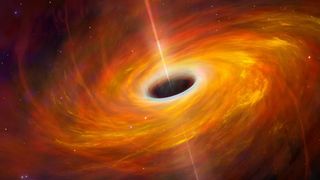
An artist’s illustration of a black hole and its accretion disk.
(Image credit: Mark Garlick/Science Photo Library/Getty Images)
Astronomers have observed matter plunging into the mouth of a black hole at the speed of light, proving a key prediction made by Einstein right, yet again.
In 1915, Einstein’s general theory of relativity predicted that once matter gets sufficiently close to a black hole, the immense force of the space-time tear’s gravity should force it to abandon a circular orbit and plunge straight in.
Now, X-ray observations made with NASA’s NuSTAR and NICER space telescopes have finally confirmed that this so-called “plunging region” exists. The scientists behind the discovery say studying it could reveal some fundamental mysteries about black holes and the nature of space-time. The researchers published their findings May 16 in the journal Monthly Notices of the Royal Astronomical Society.
“This is the first look at how plasma, peeled from the outer edge of a star, undergoes its final fall into the [center] of a black hole, a process happening in a system around 10,000 light years away,” lead author Andrew Mummery, a physicist at Oxford University, said in a statement. “What is really exciting is that there are many black holes in the galaxy, and we now have a powerful new technique for using them to study the strongest known gravitational fields.”
Black holes are born from the collapse of giant stars and grow by gorging on gas, dust, stars and other black holes. The cosmic monsters have such a powerful gravitational pull that nothing (not even light) can escape their maws.
Related: 1st detection of ‘hiccupping’ black hole leads to surprising discovery of 2nd black hole orbiting around it
But this doesn’t mean that black holes can’t be seen. Active black holes are surrounded by accretion disks — vast plumes of material that is stripped from gas clouds and stars and heated to red-hot temperatures by friction as it spirals into the black holes’ mouths.
Get the world’s most fascinating discoveries delivered straight to your inbox.
By pointing the two space telescopes at a black hole called MAXI J1820+070, located inside a binary system roughly 10,000 light-years from Earth, the researchers detected X-rays emitted by the scorching material of its accretion disk. Placing their X-ray data into mathematical models, they discovered that the two only matched if the models included light coming from matter in the plunging region — confirming its existence.
“Einstein’s theory predicted that this final plunge would exist, but this is the first time we have been able to demonstrate it happening,” Mummery said. “Think of it like a river turning into a waterfall — hitherto, we have been looking at the river. This is our first sight of the waterfall.”
By collecting and studying more light from this cosmic cascade, the researchers say that they will gain unprecedented insights into the extreme conditions around black holes. Plunging regions sit just outside of black holes’ event horizons — points of no return where gravity becomes so strong that not even light can escape.
“We believe this represents an exciting new development in the study of black holes, allowing us to investigate this final area around them. Only then can we fully understand the gravitational force,” Mummery said. “This final plunge of plasma happens at the very edge of a black hole and shows matter responding to gravity in its strongest possible form.”
Ben Turner is a U.K. based staff writer at Live Science. He covers physics and astronomy, among other topics like tech and climate change. He graduated from University College London with a degree in particle physics before training as a journalist. When he’s not writing, Ben enjoys reading literature, playing the guitar and embarrassing himself with chess.
>>> Read full article>>>
Copyright for syndicated content belongs to the linked Source : Live Science – https://www.livescience.com/space/black-holes/scientists-discover-bizarre-region-around-black-holes-that-proves-einstein-right-yet-again




















![Forest ecology cannot be reduced to arithmetic, says M.I. Varghese [Interview] – Mongabay-India](https://earth-news.info/wp-content/uploads/2025/12/328946-forest-ecology-cannot-be-reduced-to-arithmetic-says-mi-varghese-interview-mongabay-india-350x250.jpg)










![Forest ecology cannot be reduced to arithmetic, says M.I. Varghese [Interview] – Mongabay-India](https://earth-news.info/wp-content/uploads/2025/12/328946-forest-ecology-cannot-be-reduced-to-arithmetic-says-mi-varghese-interview-mongabay-india-120x86.jpg)